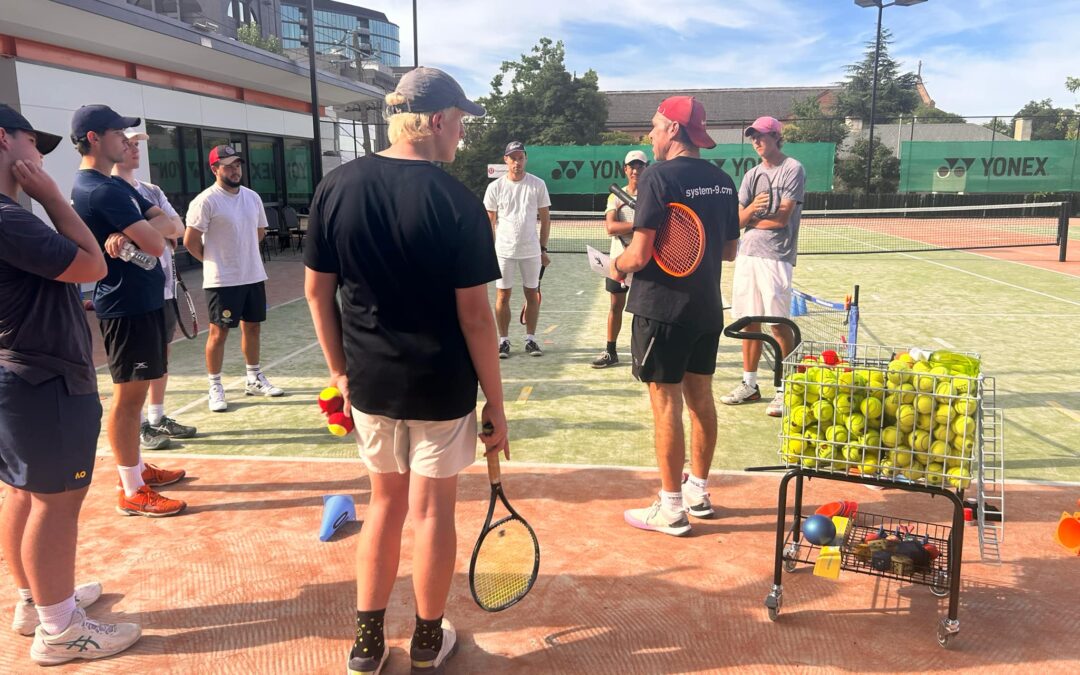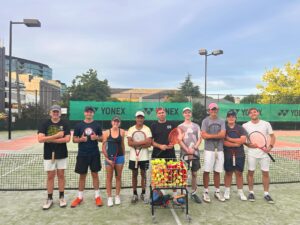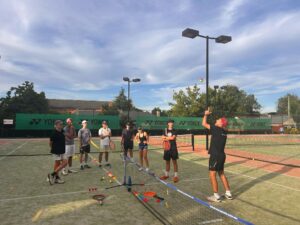After an exhausting 25-hour journey spanning three days, the thrill of finally landing in Melbourne at 1:30 PM was incomparable. By 4:00 PM, we were already checked into our hotel and soaking in the electric atmosphere at the Australian Open. For me, this tournament is a standout among the four Grand Slam events. The combination of the warm Australian summer, the passionate fans, and the incredible level of tennis makes it an unparalleled experience.
Diving Into the Action: Networking, Supporting, and Junior Tennis
The first few days were packed with a blend of networking, meeting new people, and immersing myself in the thrilling world of junior tennis. What added a personal touch to this year’s Open was the opportunity to cheer on two talented Great Britain players: Connor Brady from Kent and Cornelia Oosthuiz, a wildcard entry in the wheelchair tennis event.
Cornelia’s story is nothing short of inspiring. I first crossed paths with her while coaching the GB Army team. Watching her flourish as a wheelchair tennis player for Great Britain, after transitioning from her time in the forces, was truly a moment of pride and admiration.
One of my favorite aspects of the Australian Open has always been junior tennis. The juniors offer a fascinating glimpse into the future of the sport, and I love observing the nuances in their gameplay and the strategies employed by their coaches. It’s remarkable to think that among these young athletes could be the next big stars to dominate the tennis world.
A Thought on Funding: The Italian and UK Tennis Divide
As much as I enjoy watching junior matches, they also spark reflections on the contrasting approaches to tennis funding in different countries. For instance, Italy’s tennis federation fully funds its junior players’ travel expenses, including support for their coaches. It’s a commendable system that places immense value on nurturing talent.
Meanwhile, in the UK, players only receive funding if they make it into the main draw of a tournament. This stark difference leaves me questioning the effectiveness of the UK’s system. For British tennis to thrive, we must rethink our approach to supporting players, especially during their development years. Could a more comprehensive funding model transform the sport in the UK? I certainly believe so.
The Tactical Mindset of Junior Players
One intriguing element of junior tennis is the strategy—or lack thereof—in some matches. In one particular match, I noticed that after six games, only one wide ball had been hit. It was a winner, but it made me wonder why players don’t utilise more variety in their shots.
Of course, the risk of hitting wide while the ball is rising over the baseline is understandable, but tennis is a game of calculated risks. Could they mix things up more often? Adding variety to gameplay doesn’t just keep opponents on their toes; it also showcases a higher level of tennis IQ.
On a brighter note, it was thrilling to observe Taylor Fritz hitting with Pat Brady. To my surprise, Fritz was employing many patterns directly from my singles tactics course and book. Seeing those strategies applied at such a high level was a moment of quiet pride.
Sitting Behind the Coaches: Humour and Learning Combined
One of my guilty pleasures at tournaments is sitting behind coaches during matches. Not only is it an excellent way to pick up new insights, but it’s also often hilarious. The intense emotions of coaches can lead to some unforgettable commentary.
Some classic lines I overheard during this trip include:
- “You’re hitting on the back foot too much!”
- “Not enough spin on the ball, come on!”
- “How did you miss that?!”
These moments remind me of how crucial it is to have predetermined cues for players. Simple, rehearsed reminders can help a player refocus in high-pressure situations. That said, it’s always a fine line—overthinking can quickly turn into a “don’t think about pink elephants” scenario, where the focus on avoiding mistakes leads to more of them.
Coaching Highlights: SYSTEM-9 Red Ball Course
On the second day, I ran my SYSTEM-9 red ball course for a group of coaches at a local club in Camberwell. The reception was fantastic, and by the end of the session, another club expressed interest in hosting the course later in the week. This enthusiasm speaks volumes about the coaching culture in Melbourne and their eagerness to adopt innovative methods.
The course itself focuses on building foundational skills for young players using red balls, which are lighter and slower. These tools are perfect for teaching children the fundamentals of tennis while keeping the game enjoyable and engaging. Seeing the coaches’ excitement about implementing these strategies was incredibly rewarding.
Spotlight on Hannah Klugman: A Rising Star
On Monday, I had the pleasure of watching 15-year-old Hannah Klugman compete. Having seen her play last year, the difference in her physique and overall development was astonishing. Her growth—both in terms of height and power—was remarkable. I can’t help but wonder what her training regimen has been like. Whatever she’s doing, it’s working wonders, and I can’t wait to see how her career unfolds.
A Final Word: Melbourne’s Magic and Tennis Insights
The Australian Open isn’t just a tennis tournament; it’s a celebration of the sport and the community it fosters. From the juniors with their untapped potential to seasoned players like Taylor Fritz refining their strategies, there’s always something to learn and admire.
Melbourne’s vibrant tennis culture, combined with its warm hospitality, makes it a haven for tennis enthusiasts. As I prepare to hit the courts again with Olly, I’m filled with anticipation for what the rest of the week holds!
Andy



